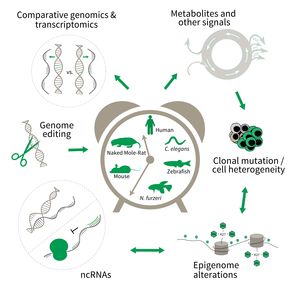Subarea 3: Genetics and Epigenetics of Aging
The focus of Subarea 3 is on genetic and epigenetic determinants of life- and health span as well as aging in fish, rodents and humans. This line of research builds on the expertise of the institute in comparative and functional genomics.
The research is defined by five focus areas:
- Comparative genomics in short- and long-lived models of aging,
- Genomic engineering in N. furzeri,
- Epigenetics of aging,
- Non-coding RNAs in aging, and
- Comparative transcriptomics of aging.
Research focus of Subarea 3.
To uncover causative factors for aging, comparative genomics in short- and long-lived model systems are applied. Functional genomics is used to identify novel pathways contribute to aging of an organism and to validate the functional relevance of genetic and epigenetic changes that occur during aging. Furthermore, genetic risk factors for aging-related diseases are identified and functionally tested. The future development of the Subarea aims to integrate changes in host-microbiota interactions during aging, and how these influence clonal mutation and epigenetic alterations through metabolites and other signals.
Publications
(since 2016)
2022
- Comparative study of ten thogotovirus isolates and their distinct in vivo characteristics.
Fuchs J, Lamkiewicz K, Kolesnikova L, Hölzer M, Marz M, Kochs G
J Virol 2022, 96(5), e0155621 - The Wilms Tumor Gene wt1a Contributes to Blood-Cerebrospinal Fluid Barrier Function in Zebrafish.
Hopfenmüller* VL, Perner* B, Reuter H, Bates TJD, Große A, Englert C
Front Cell Dev Biol 2022, 9, 809962 * equal contribution - Epigenetic stress response during dietary restriction in ageing intestine
Husak O
Dissertation 2022, Jena, Germany - New lessons on TDP-43 from old N. furzeri killifish.
Louka A, Bagnoli S, Rupert J, Esapa B, Tartaglia GG, Cellerino A, Pastore A, Terzibasi Tozzini E
Aging Cell 2022, 21(1), e13517 - Establishment and evaluation of module-based immune-associated gene signature to predict overall survival in patients of colon adenocarcinoma.
Lu J, Annunziata F, Sirvinskas D, Omrani O, Li H, Rasa SMM, Krepelova A, Adam L, Neri F
J Biomed Sci 2022, 29(1), 81 - WT1 transcription factor impairs cardiomyocyte specification and drives a phenotypic switch from myocardium to epicardium.
Marques IJ, Ernst A, Arora P, Vianin A, Hetke T, Sanz-Morejón A, Naumann U, Odriozola A, Langa X, Andrés-Delgado L, Zuber B, Torroja C, Osterwalder M, Simões F, Englert C, Mercader N
Development 2022, 149(6), dev200375 - RNA-seq analysis of brain aging in wild specimens of short-lived turquoise killifish. Commonalities and differences with aging under laboratory conditions.
Mazzetto M, Caterino C, Groth M, Ferrari E, Reichard M, Baumgart M, Cellerino A
Mol Biol Evol 2022, 39(11), msac219 - Correction to: The androgen receptor-lncRNASAT1-AKT-p15 axis mediates androgen-induced cellular senescence in prostate cancer cells.
Mirzakhani K, Kallenbach J, Rasa SMM, Ribaudo F, Ungelenk M, Ehsani M, Gong W, Gassler N, Leeder M, Grimm MO, Neri F, Baniahmad A
Oncogene 2022, 41(7), 1071-7 - The androgen receptor-lncRNASAT1-AKT-p15 axis mediates androgen-induced cellular senescence in prostate cancer cells.
Mirzakhani K, Kallenbach J, Rasa SMM, Ribaudo F, Ungelenk M, Ehsani M, Gong W, Gassler N, Leeder M, Grimm MO, Neri F, Baniahmad A
Oncogene 2022, 41(7), 943-59 - Taxonomic classification of DNA sequences beyond sequence similarity using deep neural networks.
Mock F, Kretschmer F, Kriese A, Böcker S, Marz M
Proc Natl Acad Sci U S A 2022, 119(35), e2122636119









